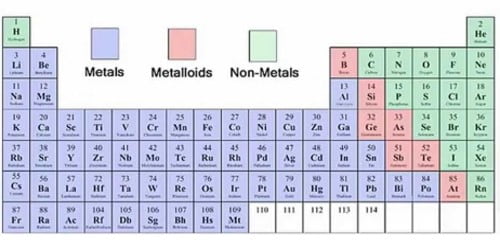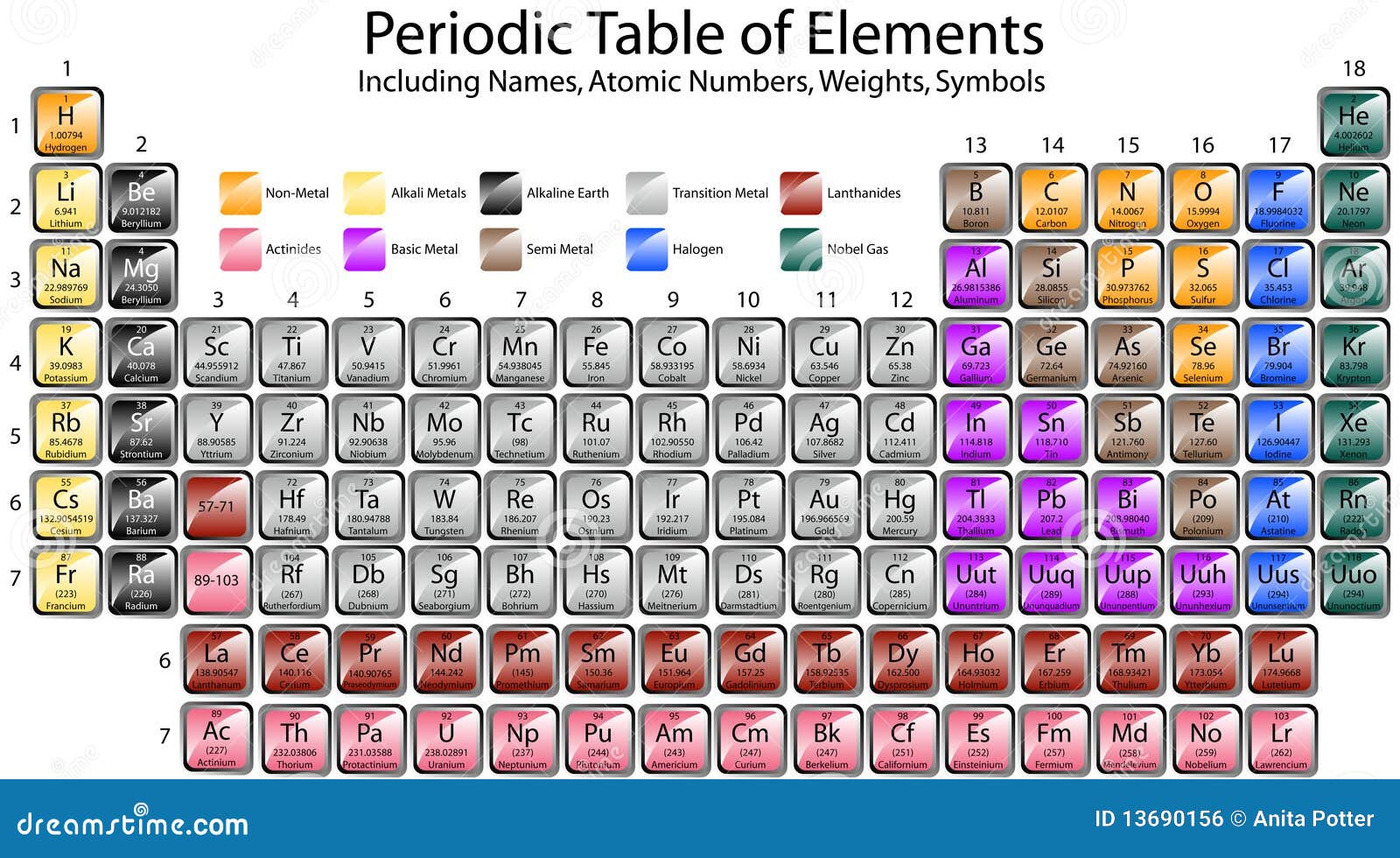39 periodic table with metal and nonmetal labels
Periodic Table of the Elements - Metals Periodic Table of Elements Metals The elements are divided into two main types, metals and nonmetals, based on their properties. About 75% of the elements are classified as metals. The name metal comes from the Greek word "m tallon" meaning "mine, quarry, metal". Properties of metals: Mostly solids Hard, shiny, malleable meaning flexible Metals, Nonmetals, and Metalloids of the Periodic Table Elements of the periodic table are grouped as metals, metalloids or semimetals, and nonmetals. The metalloids separate the metals and nonmetals on a periodic table. Also, many periodic tables have a stair-step line on the table identifying the element groups. The line begins at boron (B) and extends down to polonium (Po).
Periodic Table of Elements - PubChem Such was the case when IUPAC recently reviewed elements 113, 115, 117 and 118, and decided to give them official names and symbols (goodbye, ununseptium and hello, tennessine!). Atomic weights found within a periodic table one might think are constant. The truth is that atomic weights have changed as a function of time.

Periodic table with metal and nonmetal labels
The Parts of the Periodic Table - Angelo State University The metals are to the left of the line (except for hydrogen, which is a nonmetal), the nonmetals are to the right of the line, and the elements immediately adjacent to the line are the metalloids. When elements combine to form compounds, there are two major types of bonding that can result. Ionic bonds form when there is a transfer of electrons ... Labeled Periodic Table of Elements with Names - Science Struck Non-Metals: Hydrogen, Carbon, Nitrogen, Oxygen, Phosphorus, Sulfur and Selenium are seven non-metals located in the 14th, 15th and 16th group of the periodic table. These elements are very brittle and do not easily conduct electricity. Noble Gases: Noble gases are located in 18th group of the periodic table. Helium, Neon, Argon, Krypton, Xenon ... Basic Types of Metals on the Periodic Table - YourDictionary The transition metals are found in the center of the main body of the Periodic Table. They are sometimes called heavy metals and are denser than alkali or alkaline earth metals. There are 38 transition metals including: cobalt. copper. gold. iron. mercury. platinum.
Periodic table with metal and nonmetal labels. Periodic table - Wikipedia The periodic table, also known as the periodic table of the (chemical) elements, is a tabular display of the chemical elements.It is widely used in chemistry, physics, and other sciences, and is generally seen as an icon of chemistry. It is a graphic formulation of the periodic law, which states that the properties of the chemical elements exhibit a periodic dependence on their atomic numbers. Metals and non-metals in the periodic table - The periodic table - AQA ... Metals are on the left of the periodic table, and non-metals are on the right. Atomic structure and the periodic table Elements in group 1 and group 2 are metals. Atoms of group 1 elements have one... Metals, Non-Metals and Metalloids - GeeksforGeeks Metals, non-metals, and metalloids are the most common elements. Compounds, on the other hand, are pure entities formed by the chemical combination of two or more elements in a predetermined ratio. Chemical procedures, on the other hand, can break down these compounds into individual elements. e.g. gold, copper, oxygen, chlorine, diamond, etc. The Periodic Table: Metals, Nonmetals, and Metalloids Using the periodic table, you can classify the elements in many ways. One useful way is by metals, nonmetals, and metalloids. The periodic table is organized in families and periods . Metals In the periodic table, you can see a stair-stepped line starting at Boron (B), atomic number 5, and going all the way down to Polonium (Po), atomic number 84.
Metals and Non Metals of the Periodic Table From Group 13 to 16 these are a mixture of metals, non-metals, and semimetals. For example Group 15 contains the non-metals Nitrogen and Phosphorus, the semi-metal Arsenic and the metals Antimony and Bismuth. These non metals have very different properties to metals, they do not tend to barde shiny and wont conduct heat or electricity well. Labeled Periodic Table of Elements with Name [PDF & PNG] There are 18 groups in the periodic table, which consists of metal and nonmetal. Protons in the tables are positively charged particles. Neutrons are the neutrally negative charge, and electrons are the negative charge particles. It also shows the formation of a bond from one element to the other. PDF Labelled Periodic Table with Charges Periodic Table: Metals, Non-metals, and Metalloids - Quizlet Metalloid. the set of elements that separate the metals from the nonmetals on the periodic table and that possess properties of both metals and nonmetals. Period. a row on the periodic table. Group. a column on the periodic table, also known as a chemical family since elements in groups share similar chemical properties. Blocks of the Periodic Table: s-block, p-block, d-block, f-block Non - Metals Non-metals are located at the top right-hand side of the Periodic Table. In a horizontal row, the property of elements changes from metallic on the left to non-metallic on the right. Non-metals are usually solids or gases at room temperature with low melting and boiling points. They are poor conductors of heat and electricity.
Metal and non-metal oxides - The periodic table - BBC Bitesize Metals are on the left of the periodic table, and non-metals are on the right Oxides are substances made of two or more types of chemically bonded together. All are compounds, and contain a single... Metals and non-metals in the periodic table - PubMed A link between that theory and the work of Sir Nevill Mott on the metal-non-metal transition is also highlighted. The application of the 'simple', but highly effective Goldhammer-Herzfeld and Mott criteria, reveal when a chemical element of the periodic table will behave as a metal, and when it will behave as a non-metal. Labeled Periodic Table - Science Trends Semimetals, or metalloids, have properties which are in between metals and nonmetals. These properties are: Can be either dull or shiny Often effective semiconductors Can lose or gain electrons in chemical reactions Have several different forms Nonmetals are elements that have properties which are quite distinct from metals. Difference Between Metals And Nonmetals - Byju's Difference Between Metals and Nonmetals- The elements present on the extreme right side of the periodic tables are non-metal, About 80 of the 105 elements in the periodic table are regarded as metals. To Learn the major differences between Metals and Nonmetals. Understand the definition, properties & uses of metals and non-metals, Visit BYJU'S for more content
Periodic Table of Elements: Los Alamos National Laboratory Metalloid (or "semi-metal" or "poor metal"). The metalloids are B, Si, Ge, As, Sb, Te, and Po. They sometimes behave as semiconductors (B, Si, Ge) rather than as conductors. Lanthanides. The lanthanides comprise elements 57 (lanthanum, hence the name of the set) through 71. They are grouped together because they have similar chemical properties.
Metals Non metals Metalloids | Science - Quizizz Metals Non metals Metalloids. durga_kanumuri_59118. a day ago. 0% average accuracy. 0 plays. 7th grade . Science. 0. Save. ... Tags: Topics: Question 3 . SURVEY . Ungraded . 900 seconds . ... Where are the non-metallic elements found in the periodic table? answer choices . In the middle. In the top rows. On the left-hand side.
Different Types of Metals on the Periodic table (With Image) There are total 17 Rare Earth metals on the Periodic table. Rare Earth Metals includes all the 15 Lanthanides as well as scandium (Sc) and yttrium (Y). So total 15 + 2 = 17 Rare Earth metals. If you are thinking that rare earth metals are those types of metals on Periodic table which are very rarely available, then you are WRONG.
List of Metals - Science Notes and Projects Location of Metals on the Periodic Table. Over 75% of the elements are metals, so they fill most of the periodic table. Metals are on the left side of the table. The two rows of elements below the main body of the table (the lanthanides and actinides) are metals. Uses of Metals. Metals find use in every aspect of life. Here is a list of some of ...
Groups and Periods of the Periodic Table --------------------Metals ... Metals (left side of a period) generally have a lower electron affinity than nonmetals (right side of a period), with the exception of the noble gases. According to their shared physical and chemical properties, the elements can be classified into the major categories of metals, metalloids and nonmetals. Metals Most elements are metals.
PDF Metals Non-Metal Metalloids and the Periodic Table The Metals are represented in the Periodic Table in blue. The Periodic Table H He Li Be B C N O F Ne Na Mg Al Si P S Cl Ar K Ca Sc Ti V Cr Mn Fe Co Ni Cu Zn Ga Ge As Se Br Kr ... The Non-Metals are represented in the Periodic Table in yellow. The Periodic Table H He Li Be B C N O F Ne Na Mg Al Si P S Cl Ar K Ca Sc Ti V Cr Mn Fe Co Ni Cu Zn Ga ...
What Are the Parts of the Periodic Table? - ThoughtCo Metalloids (or Semimetals) There is a zig-zag line toward the right side of the periodic table that acts as a sort of border between metals and nonmetals. Elements on either side of this line exhibit some properties of metals and some of the nonmetals. These elements are the metalloids, also called semimetals.
Metals and Non Metals | Metals - Quizizz Tags: Topics: Question 3 . SURVEY . Ungraded . 60 seconds . Report an issue . Q. Which of these is a metal? ... Both metals and non metals answer explanation . Tags: Topics: Question 5 . SURVEY . Ungraded . 120 seconds ... What side of the periodic table are metals on? answer choices . left. right. top. bottom. left . alternatives .





Post a Comment for "39 periodic table with metal and nonmetal labels"